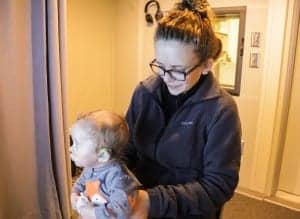Deaf children face unique communication challenges, but a new study shows that the effects of hearing impairment extend far beyond language skills to basic cognitive functions, and the differences in development begin surprisingly early in life. Researchers at The Ohio State University Wexner Medical Center are reportedly the first to study how deaf infants process visual stimuli compared to hearing infants and found they took significantly longer to become familiar with new objects, the academic medical center announced on its website.
“This is somewhat counterintuitive because a lot of people assume that deaf children compensate for their lack of hearing by being better at processing visual things, but the findings of the study show the opposite,” said Claire Monroy, post-doctorate otolaryngology fellow at The Ohio State University Wexner Medical Center and co-author of the study.
To test their visual processing skills, researchers showed infants different objects on a screen. When a baby has successfully encoded the object, they will lose interest and look away. This familiarization is what researchers call habituation.

A deaf infant observes objects on a screen in a study conducted by The Ohio State University Wexner Medical Center to examine cognitive development. The study found that differences in development among hearing-impaired babies exist even among visual learning and begin very early in life.

Claire Monroy observes a deaf infant in a study at The Ohio State University Wexner Medical Center testing babies’ visual processing skills. They found that deaf infants took longer to encode visual stimuli than hearing infants.
“Deaf infants took longer to habituate to the objects and looked away from them less than hearing infants,” said Derek Houston, associate professor of otolaryngology at Ohio State. “These results were surprising because you wouldn’t expect there to be such profound differences in a test that really has nothing to do with hearing.”
However, researchers say the results don’t necessarily mean that deaf children are learning at a slower pace.
“Because they use vision to process the world around them, they may pay closer attention to visual objects,” said Houston. “They might actually be processing more about each object.”
Future research will examine why these differences in visual learning exist so that each child is taught in a way that works best for them and leads to healthy development.
“Understanding the source of these differences can really help us tailor interventions specifically for these children,” said Monroy. “And the earlier that happens, the better.”
Source: The Ohio State University Wexner Medical Center
Images/Video: The Ohio State University Wexner Medical Center





